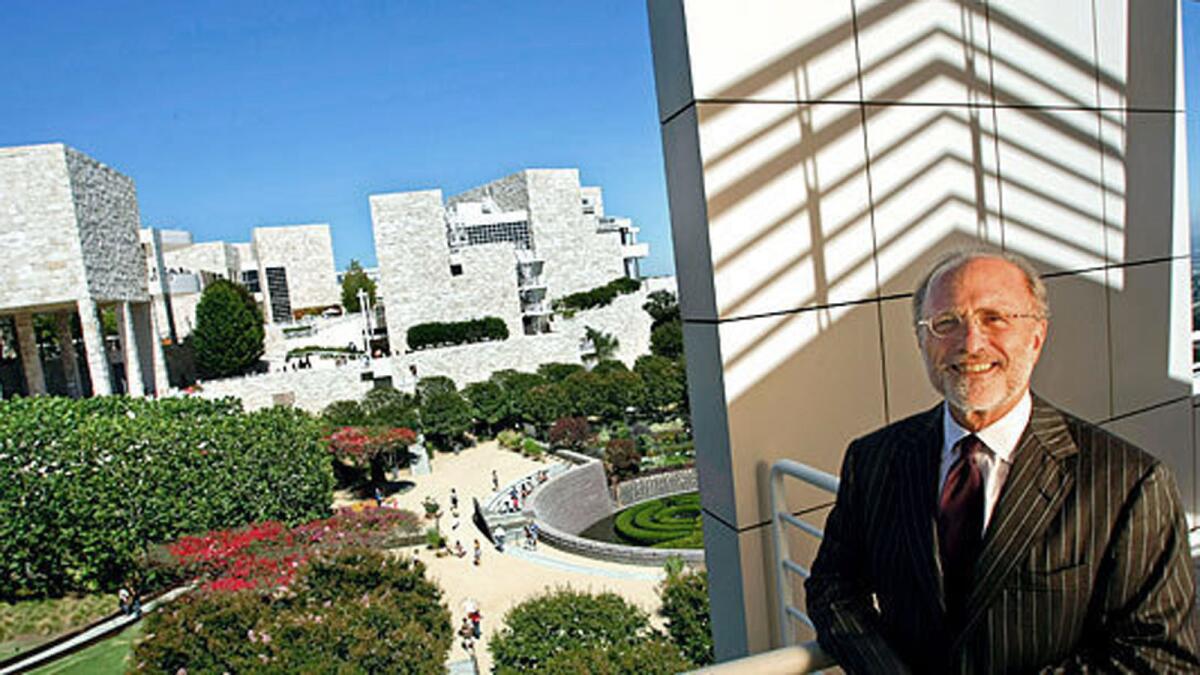Getty’s James Cuno defends museums’ right to keep ancient art

James Cuno, president of the J. Paul Getty Trust, is back in the fray over whether antiquities and other prized artifacts from Middle Eastern and Mediterranean cradles of Western civilization should remain in museum collections in America, Great Britain and other major collector nations or be sent back to the countries where they were created hundreds or thousands of years ago.
The latest salvo from the L.A. museum leader is an article he wrote for the November-December issue of Foreign Affairs magazine titled “Culture War: The Case Against Repatriating Museum Artifacts.”
It returns to themes Cuno explored in his 2008 book, “Who Owns Antiquity?” written while he was in his previous job, director of the Art Institute of Chicago.
The new article aims to take some of the heat off of museums such as the Getty, New York’s Metropolitan Museum of Art and London’s British Museum as they face demands from today’s governments of cradle nations for the return of their ancient forebears’ masterworks.
Officials of the U.N. Economic, Scientific and Cultural Organization’s Intergovernmental Committee for Promoting the Return of Cultural Property to its Countries of Origin met last month in Paris and resolved to try to press the British government to enter formal discussions, mediated by UNESCO, for the return of the famed Parthenon Marbles to Greece. They were removed from the Parthenon in Athens by the British Lord Elgin starting in 1801 and acquired by the British Museum in 1816.
A Getty spokeswoman said Cuno’s article, which criticizes UNESCO, was “commissioned quite some time ago” and not spurred by recent Parthenon Marbles developments, which also include George Clooney’s wife, attorney Amal Clooney, joining legal efforts to hasten the sculptures’ return to Athens.
The Getty has done more antiquities-repatriating than most; since 2007 it has sent more than 40 objects, including some of its most stunning ancient Greek and Roman sculptures, back to contemporary Italy and Greece after having agreed there was compelling evidence that they had been stolen from their native soil by looters.
Cuno has no beef with returning stolen art, including the repatriations by the Getty. Instead, his article focuses on what he considers to be an entirely different class of ancient objects that includes the Parthenon Marbles — pieces that left their native soil in the 19th and early 20th century in accordance with national laws that were then in effect in Greece, Italy, Egypt, Turkey and other cradle nations.
Cuno’s article criticizes UNESCO and the International Council of Museums for adopting “all-embracing” policy statements that seem to back any and all claims to ancient property lodged by an ancient land’s current government.
He writes that part of respecting the past is respecting decisions made during the height of Western imperialism, when, for example, the legally empowered Ottoman rulers of Greece and Egypt struck deals allowing western archaeologists or collectors to take home treasures such as the Parthenon Marbles and a famous bust of the Egyptian Queen Nefertiti owned by the Egyptian Museum in Berlin.
UNESCO directives and other criticisms are off base, Cuno writes, when they portray museums in America and Western Europe “as imperial instruments and contemporary agents of historical imbalances of power by which stronger nations continue to enrich themselves at the expense of weaker ones.”
For him, “such a view fails to account for the complexity of empire…. If one goes looking for evidence of empire in the collections of encyclopedic museums, one could find it everywhere. Empire is a fact of history, and history is on display in encyclopedic collections.”
Cuno doesn’t buy the argument that because an object was made in ancient Greece, Rome or the Middle East its proper home is back on its native soil.
“This kind of promotion of cultural purity … can produce dangerous, often violent xenophobia,” he writes. “Cultural property should be recognized for what it is: the legacy of humankind and not of the modern nation-state, subject to the political agenda of its current ruling elite.”
A counter argument often advanced by archaeologists and nations of origin holds that even prized objects need to be seen and studied in their original context to be properly understood. If museums continue to collect ancient art, they fear, it will only encourage further looting.
Cuno reiterates arguments he and others have made before: that putting all the world’s greatest ancient treasures in their original cradles is asking for trouble because natural disasters or sociopolitical mayhem could jeopardize great swaths of the ancient record.
Citing 21st century examples in which Islamic militants destroyed ancient statues of Buddha in Afghanistan and medieval manuscripts in Mali, Cuno writes that “allowing the world’s museums to share cultural property through loans or acquisitions would reduce some of these risks.”
In return for being acknowledged as legitimate permanent custodians of crucial pieces of the world’s past, Cuno says museums in wealthy lands such as the United States and Great Britain should help establish or strengthen museums in countries that can’t afford to create or improve them on their own.
He also calls for a maximum exchange of art loans among museums across the globe so that pieces of humanity’s shared patrimony can be seen as widely as possible.
Cuno ends by acknowledging that his vision runs up against some persistent realities of international affairs: “This more open future mostly depends on individual governments’ setting aside their nationalist claims and encouraging among their citizens a cosmopolitan view of the world’s many different cultures.”
Follow @boehmm of the LA Times for arts news and features
More to Read
The biggest entertainment stories
Get our big stories about Hollywood, film, television, music, arts, culture and more right in your inbox as soon as they publish.
You may occasionally receive promotional content from the Los Angeles Times.







